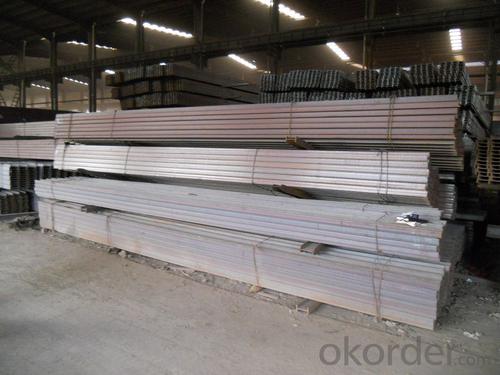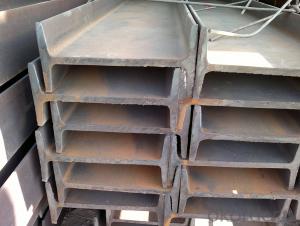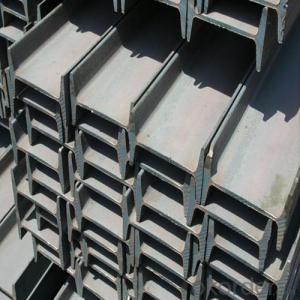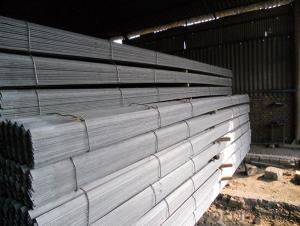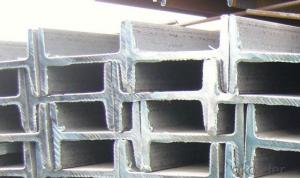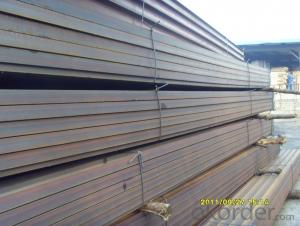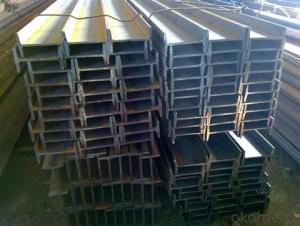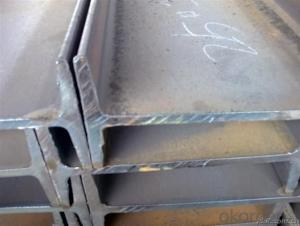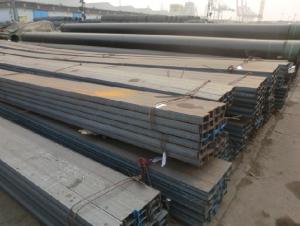Hot Rolled Steel I Beams Q235, A36, SS400 for Construction
- Loading Port:
- Tianjin
- Payment Terms:
- TT or LC
- Min Order Qty:
- 25 m.t.
- Supply Capability:
- 200000 m.t./month
OKorder Service Pledge
OKorder Financial Service
You Might Also Like
Product Description of Hot Rolled Steel I Beams Q235, A36, SS400 for Construction:
OKorder is offering Hot Rolled Steel I Beams Q235, A36, SS400 for Construction at great prices with worldwide shipping. Our supplier is a world-class manufacturer of steel, with our products utilized the world over. OKorder annually supplies products to European, North American and Asian markets. We provide quotations within 24 hours of receiving an inquiry and guarantee competitive prices.
Specifications of Hot Rolled Steel I Beams Q235, A36, SS400 for Construction
Product name: I-Beam Steel
Production Standard: GB, BS, ASTM, EN, DIN, JIS
Grade: Q235B, Q345B, ASTM A36, SS400, S235JR, S275JR
Chemical composition
Alloy No. | Grade | C | Mn | S | P | Si |
Q235 | B | 0.12%-0.20% | 0.3%-0.7% | <=0.045% | <=0.045% | <=0.3% |
Length: 5.8M, 6M, 8M, 9M, 10M, 12M or as the requirements of the buyer
Sizes: 80MM-270MM
Applications of Hot Rolled Steel I Beams Q235, A36, SS400 for Construction
Widely used in various building structures and engineering structures such as roof beams, bridges, transmission towers, hoisting machinery and transport machinery, ships, industrial furnaces, reaction tower, container frame and warehouse etc.
Package and Delivery Hot Rolled Steel I Beams Q235, A36, SS400 for Construction
1. Package: All the products will be tired by wire rod in bundles and then put into containers 20', 40' or in bulk cargo.
Or according the requirements of the customers. Each bundle will be hung a CNBM label, which will include the information of our trademark, size, material, lengh, standard, etc. Normally, each bundle contain 50 pieces.
Bundle weight: not more than 3.5MT for bulk vessel; less than 3 MT for container load
But we can also make the bundles as the requriement of you.
2. Delivery: Within 45 days after getting the L/C ORIGINAL or the advance payment by T/T.
Production flow of Hot Rolled Steel I Beams Q235, A36, SS400 for Construction
Material prepare (billet) —heat up—rough rolling—precision rolling—cooling—packing—storage and transportation
FAQ:
Q1: Why buy Materials & Equipment from OKorder.com?
A1: All products offered byOKorder.com are carefully selected from China's most reliable manufacturing enterprises. Through its ISO certifications, OKorder.com adheres to the highest standards and a commitment to supply chain safety and customer satisfaction.
Q2: The products are invoicing on theoritical weight or on actual weight?
A2: We can do it in both manners, according to the customers' request.
Q3:What's your payment terms ?
A3:Mostly,we collect the money by T/T and LC at sight . We also accept time LC at 90/120 days s
Q4: How do you guarantee the quality of products?
A4: We have established an advanced quality management system which conducts strict quality tests at every step, from raw materials to the final product. At the same time, we provide extensive follow-up service assurances as required.
Images of Hot Rolled Steel I Beams Q235, A36, SS400 for Construction:

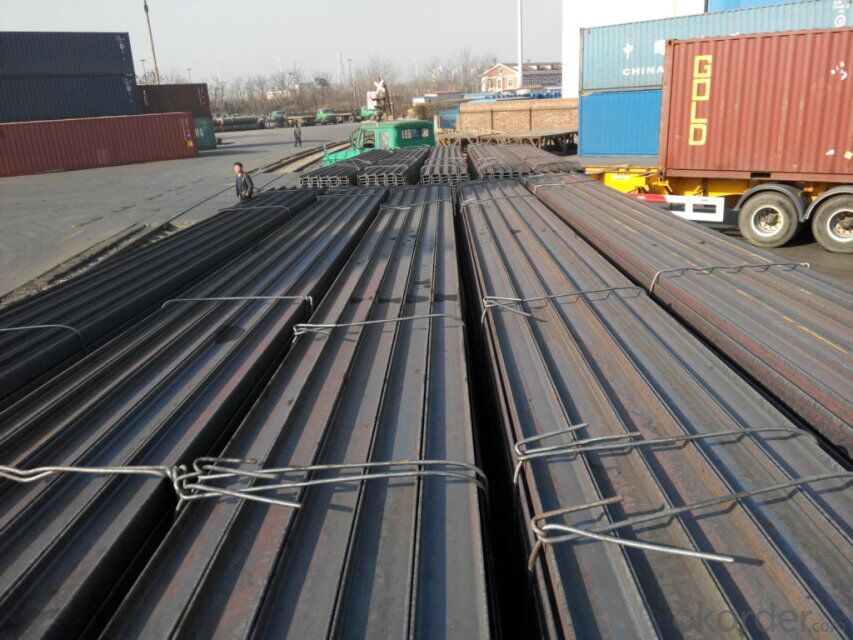
- Q: How do steel I-beams contribute to the overall fire safety of a building?
- Steel I-beams contribute to the overall fire safety of a building in several ways. Firstly, they have a high melting point, which means they are less likely to collapse or lose their structural integrity during a fire. This provides additional time for occupants to evacuate the building safely. Additionally, steel I-beams have a low thermal conductivity, meaning they do not transfer heat as readily as other materials. This reduces the spread of fire and heat throughout the building, limiting the potential damage. Finally, steel I-beams are non-combustible, meaning they do not contribute to the fuel source of a fire, further minimizing the fire risk.
- Q: Can steel I-beams be used for green building certifications?
- Yes, steel I-beams can be used for green building certifications. Steel is a sustainable material that can be recycled, and using steel I-beams in construction can contribute to the overall energy efficiency and environmental performance of a building. Steel has a high strength-to-weight ratio, allowing for the creation of large and open spaces with fewer materials, reducing the environmental impact. Additionally, steel I-beams can be designed to withstand extreme weather conditions, leading to a longer lifespan and reduced maintenance. When considering green building certifications such as LEED (Leadership in Energy and Environmental Design), the use of steel I-beams may contribute to points in categories such as Materials and Resources, Energy and Atmosphere, and Innovation in Design. However, it is important to note that the overall sustainability of a building goes beyond the choice of structural materials and includes other factors such as energy efficiency, water conservation, and indoor air quality.
- Q: Can steel I-beams be customized or fabricated to specific project requirements?
- Yes, steel I-beams can be customized or fabricated to specific project requirements.
- Q: How long do Steel I-Beams last?
- Steel I-beams have a remarkably long lifespan and can last for several decades, if not longer, depending on various factors. The durability and longevity of steel I-beams are primarily attributed to the inherent strength and resistance of steel as a construction material. When properly designed, manufactured, and maintained, steel I-beams can withstand heavy loads, extreme weather conditions, and other environmental factors that could potentially degrade their structural integrity. The lifespan of steel I-beams depends on several factors, including the quality of the steel used, the design and engineering of the structure, the level of maintenance provided, and the conditions under which the beams are exposed. High-quality steel, such as structural-grade steel, is specifically engineered to provide exceptional strength, corrosion resistance, and longevity. These beams are often galvanized or coated with protective finishes to further enhance their resistance to rust and corrosion. Additionally, the design and engineering of the structure play a crucial role in determining the lifespan of steel I-beams. Properly designed structures that evenly distribute loads and minimize stress concentrations can significantly extend the lifespan of the beams. Regular maintenance, including inspections, repairs, and the application of anti-corrosion treatments, can also enhance their durability and extend their lifespan. In ideal conditions, with appropriate maintenance and care, steel I-beams can last well over 50 years. However, it is important to note that certain factors can potentially reduce their lifespan. These factors include exposure to harsh environments, such as coastal areas with high salt content in the air, constant exposure to moisture or chemicals, and inadequate maintenance practices. Additionally, any structural modifications, improper repairs, or accidental damage can also impact the lifespan of steel I-beams. To ensure the longevity of steel I-beams, it is recommended to consult with structural engineers and adhere to maintenance guidelines provided by manufacturers. Regular inspections, prompt repairs, and appropriate maintenance practices are essential to maximize the lifespan of steel I-beams and ensure the safety and stability of the structures they support.
- Q: How are steel I-beams made?
- Steel I-beams are made through a process called hot rolling, where a steel billet is heated and passed through a series of rollers to shape it into the desired I-beam profile. The rolling process helps to enhance the structural strength and integrity of the steel, resulting in a durable and versatile beam used in construction and engineering projects.
- Q: Can Steel I-Beams be used for solar panel installations?
- Solar panel installations can indeed utilize steel I-beams. These beams are widely employed in construction due to their impressive strength and durability. Their ability to provide exceptional support for heavy loads makes them an excellent choice for bearing the weight of solar panels. Moreover, steel I-beams can be effortlessly installed and interconnected, creating a robust framework for mounting solar panels. However, it is crucial to ensure that the I-beams are appropriately sized and designed to withstand the specific load and wind conditions associated with solar panel installations. Consulting a structural engineer or a professional solar panel installer is highly recommended to guarantee the secure and efficient utilization of steel I-beams for solar panel installations.
- Q: What is the average lifespan of a steel I-beam?
- The lifespan of a steel I-beam can vary depending on several factors, including the quality of the steel, the installation environment, and the level of maintenance. Generally, a well-maintained steel I-beam can endure for many decades or even longer. By conducting regular inspections, ensuring proper cleaning, and providing sufficient protection against corrosion, a steel I-beam can remain functional for 50 years or more. However, in harsh environments characterized by high moisture levels, salt, or exposure to chemicals, the lifespan may be considerably shorter. To ensure the longevity of the steel I-beam, it is crucial to seek advice from structural engineers and adhere to manufacturer guidelines.
- Q: What are the different accessories or attachments used with steel I-beams?
- There are several accessories or attachments that are commonly used with steel I-beams to enhance their functionality and structural integrity. Some of these accessories include: 1. Beam clamps: These are used to attach the steel I-beams to other structural elements or support systems. Beam clamps come in various designs and sizes to accommodate different beam sizes and load requirements. 2. Beam connectors: These are connectors that join two or more steel I-beams together, creating a continuous beam. They are typically used in long-span applications or when additional strength is required. 3. Beam hangers: Beam hangers are used to suspend the steel I-beams from overhead structures or support systems. They provide a secure and reliable means of supporting the beams, especially in applications where there is limited space for support columns. 4. Lateral braces: Lateral braces are used to provide additional stability and prevent lateral movement of the steel I-beams. They are typically installed at regular intervals along the length of the beam and can be either welded or bolted to the beam. 5. End plates: End plates are used to connect the ends of steel I-beams to other structural elements or support systems. They are typically bolted or welded to the beam ends and provide a secure connection that can withstand high loads and forces. 6. Cleats: Cleats are small steel plates that are welded or bolted to the sides of the steel I-beams. They are used to provide additional support and prevent twisting or rotation of the beams under load. 7. Brackets: Brackets are used to support other components or fixtures that are attached to the steel I-beams. They can be either welded or bolted to the beams and are commonly used to support equipment, lighting fixtures, or other building systems. These accessories and attachments play a crucial role in ensuring the proper installation, support, and functionality of steel I-beams in various construction and structural applications.
- Q: Can steel I-beams be used in seismic retrofitting projects?
- Yes, steel I-beams can be used in seismic retrofitting projects. Steel I-beams are commonly utilized to strengthen and reinforce existing structures against seismic forces. Their strength and rigidity make them suitable for absorbing and distributing seismic energy, improving the overall structural integrity of the building.
- Q: Can steel I-beams be used in cultural or historical buildings?
- Yes, steel I-beams can be used in cultural or historical buildings. While traditional construction materials like wood or stone are often associated with cultural or historical buildings, steel I-beams offer several advantages such as strength, durability, and versatility. Incorporating steel I-beams into the design of cultural or historical buildings can provide structural support, allow for larger open spaces, and enhance the overall architectural aesthetic. However, careful consideration should be given to ensure that the use of steel I-beams does not compromise the historical or cultural significance of the building.
Send your message to us
Hot Rolled Steel I Beams Q235, A36, SS400 for Construction
- Loading Port:
- Tianjin
- Payment Terms:
- TT or LC
- Min Order Qty:
- 25 m.t.
- Supply Capability:
- 200000 m.t./month
OKorder Service Pledge
OKorder Financial Service
Similar products
Hot products
Hot Searches
Related keywords



